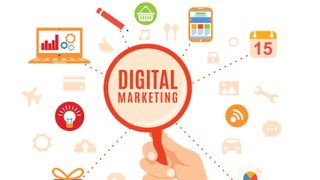What is digital marketing? | A guide to online marketing
Digital marketing, aka online marketing or internet marketing, has transformed the way we shop, share content and engage with brands. But what is it? We explore.

What is digital marketing?
Digital marketing is the process of publishing online marketing communications, promotions and digital advertisements. Often, these online marketing efforts are targeted, sometimes paid for, and may double up as direct digital sales alongside product or service promotion.
How to do digital marketing
To implement a digital marketing campaign you'll need the essentials: access to a computer, an internet connection and the ability to create appealing digital marketing content—including research or other relevant digital marketing materials for your target audience.
Once you've designed these, you can develop and publish them to reach your customer across any device or channel which receives digital formats: websites, apps, search engines, email, social media, and hardware-wise phones, desktop, laptop, billboards, tablet, or smartwatch.
The combination of marketing across a mix of channels is commonly referred to as an omnichannel digital marketing strategy.
Software and marketing tools play a vital role in running a successful digital marketing campaign. CRM software will help connect sales, customers, and digital marketing. Find our more in our guide to the best CRMs and our article: What is a CRM.
Digital marketing examples
If you found this article via search engine or social media there's a healthy chance you've already come across plenty of examples of digital marketing today.
Many of the first results we see during internet browsing are digital content marketing adverts, with Search Engine Watch reporting "55% of searchers don’t know which links in the SERPs are PPC ads, according to a new survey" and Search Engine Journal finding "Over 25% of People Click the First Google Search Result."

Combine this with the fact that Google (who have over ¾ of the search market industry share) have recently axed 5.5% of their organic first page results listings in favour of more digital marketing ad space, and you'd be forgiven for not noticing.
Are you a pro? Subscribe to our newsletter
Sign up to the TechRadar Pro newsletter to get all the top news, opinion, features and guidance your business needs to succeed!
Increasingly, digital marketing compels or demands our attention and time across digital spaces. According to Pew Research Center, 85% of adults in the US go online every day, and 31% of them stay online almost constantly.
As a marketer or small business owner, that means your focus should be to construct an effective digital strategy to capture the attention of your target audience across all digital channels.
However, navigating the vast landscape of digital marketing can seem quite overwhelming.
So, we’ve put together this useful guide that explores the ins and outs of digital marketing, including some great examples from well-known brands and the best digital marketing software that can help you run successful campaigns.
Let’s get started.

How to run a Digital Marketing campaign

How to run a Digital Marketing campaign
Typical digital marketing objectives include reaching a new audience, increasing online sales by a certain percentage, improving company visibility or launching new products and services.

How to run a Digital Marketing campaign
Consider who your product or service could most help and how to sell to them.

How to run a Digital Marketing campaign
The final step to executing a successful digital marketing campaign is to tailor all digital content to your audiences interests and needs before publishing it.

How to run a Digital Marketing campaign
How does digital marketing work?
Digital marketing (also known as online marketing) is an umbrella term for various techniques used to promote a product or service via digital communication channels.
Digital marketing encompasses a wide array of marketing techniques (such as content marketing, search engine optimization, social media marketing, etc.) that use the internet to promote a brand and its products/services.
It also involves the use of digital marketing platforms, such as search engines (Google, Bing), social media (Instagram, Facebook, Twitter), and communication tools (email, instant messaging, mobile).
Digital advertising spending worldwide amounted to $378.16 billion U.S. dollars in 2020
Statista
Today, businesses of all sizes leverage digital marketing to generate quality leads, drive conversions, and boost customer retention. When implemented correctly, it can help you build lasting customer relationships and a loyal customer base that steers your business towards greater success.
Consumers today meanwhile, rely greatly on digital and social channels to research products before buying. Whether you’re selling office furniture, camping gear, or project management software, digital marketing can help you connect with your target audience quickly and cost-effectively.
Digital marketing allows you to gather valuable insights into consumer behaviors. The data you collect over time will enable you to create meaningful interactions with new and existing customers. By engaging them meaningfully, you can build awareness and put your brand in front of your target audience when they are ready to buy.
Why is digital marketing important?
Digital marketing is important for online businesses and brick-and-mortar stores to expand brand visibility and offer a 24/7 sales channel online. Apart from being excellent for brand-identity building, digital marketing also helps to maximize customer conversions, add character and modernization businesses, as well as increase revenue.
Consider the brands below. Without so much as a company name, you likely already know which social platforms and companies these are thanks to digital marketing. Try to imagine how much you would've known about them without seeing the brand's digital marketing efforts. Would you still recall them so easily?

The growth of digital marketing skyrocketed during the COVID-19 pandemic. In fact, most B2B seller interactions have now moved online — which is exactly what customers want. Almost 80% of B2B buyers prefer digital self-service or remote interactions.
When did digital marketing start?
While digital marketing has risen to prominence in the last decade, it’s been around since the early 1990s. Its inception began with the introduction of Web 1.0.
Clickable banners were some of the earliest digital marketing formats with the first one going live in 1994. This was followed by the launch of Yahoo in 1994 and Google in 1998.

As search engine traffic continued to surge through the 2000s, marketers relied on SEO and pay-per-click (PPC) to attract business leads and customers. The next big leap in digital marketing came with the launch of MySpace in 2003 and Facebook in 2004. The growing use of digital marketing has also led to the development of popular digital marketing tools and the rise of digital marketing agencies.
The benefits of digital marketing

Digital marketing benefits businesses that are looking to expand their reach beyond traditional advertising channels. Regardless of where you’re located, you can connect with customers across the globe through various digital marketing channels such as social media, email, search engines, and streaming platforms.
Develop product development from user feedback
Much of digital marketing is interactive and often attracts customer feedback on products and services via reviews sites or social media commentary.
Reading feedback directly from a customer base who not only know and enjoy your product/service but also want to offer suggestions on development to help your business flourish is truly invaluable.
In turn, it also helps you understand their preferences, aspirations, and struggles better so you can personalize your digital marketing campaigns for different customer segments. In fact, personalization is the <a href="https://hubspot.sjv.io/c/221109/976131/12893?subId1=hawk-custom-tracking&sharedId=hawk&u=https%3A%2F%2Fwww.hubspot.com%2Fhubfs%2FState-of-Marketing%2520%282%29.pdf%3Fhubs_post%3Dblog.hubspot.com%252Fmarketing%252Fdata-personalize-marketing-li%26hubs_post-cta%3DHubSpot%26_ga%3D2.106325379.1086911280.1634466518-169964645.1619206965" data-link-merchant="hubspot.com"" target="_blank" rel="nofollow">most widely used marketing tactic for driving email engagement.
Patagonia is a company that puts its ethical business practices at the forefront of its digital marketing activities. They create thoughtful content on their website and social media promoting their social and environmental initiatives that sets them apart from other outdoor brands.

Dollar Shave Club used video marketing way back in 2012 to launch their business. They posted a light-hearted and entertaining video on YouTube that echoed the struggles most men face while shaving.

The video has garnered more than 27 million views and helped the company attract more than 1 million paid subscribers. In 2016, Dollar Shave Club was acquired by Unilever for $1 billion.
What are the different types of digital marketing?
Depending on the target demographic, digital marketing can be categorized into B2B digital marketing and B2C digital marketing. What distinguishes these two types of online marketing is the buyer’s journey.

B2B (business to business) digital marketing
B2B digital marketing targets key decision-makers in an organization. Their buyer’s journey is complex, longer, and nonlinear. Also, B2B marketing campaigns often target multiple stakeholders in the same company. You need to provide your target buyers with valuable, enriching, and well-researched content that’ll help them make a purchase decision.
B2C (business to consumer) digital marketing
On the other hand, B2C digital marketing involves addressing the end consumer’s pain points. You can use humor, fear, and other emotions to strike a chord with your target audience. Most audience segments go through a simple and linear buyer’s journey.
Additionally, digital marketing can be categorized into various types depending on the technique you’re using. Often these types are simplified into the 7 types of digital marketing. We define the 7 digital marketing techniques and types below:
Content marketing
Content marketing involves the ideation, creation, and distribution of high-quality, engaging, and meaningful content to the right audience through different online communication channels.
Regardless of your target audience and end goals, outstanding content is the backbone of your digital marketing strategy. This content can be in the form of blog posts, videos, images, infographics, etc.
Search engine marketing (SEM)
SEM can be further categorized into SEO and PPC advertising. SEO covers the various techniques used to drive high organic traffic from search engines to your website.
On the other hand, PPC advertising involves creating paid ads that help you claim top real estate on search engine results pages (SERPs). You get charged every time a user clicks on your search engine ad.
Social media marketing
Social media marketing involves the creation and distribution of insightful and entertaining content on various social media platforms.
It helps to build brand awareness, generate leads and sales, and strengthen brand reputation. Make sure you choose the right platforms and content formats that’ll appeal to your target audience.
Email marketing
Email marketing continues to be a powerful lead nurturing and relationship-building strategy that leverages emails to promote your brand and engage your audience.
Emails allow you to have one-on-one conversations with your audience and this can go a long way in driving sales. Digital marketing software like <a href="https://www.anrdoezrs.net/click-6361382-15624204?sid=hawk-custom-tracking&url=https://mailchimp.com/" data-link-merchant="mailchimp.com"">Mailchimp and <a href="https://www.activecampaign.com/" data-link-merchant="activecampaign.com"" data-link-merchant="mailchimp.com"">ActiveCampaign can help you run personalized email marketing campaigns for individual audience segments.
Some of the most commonly used emails include cart abandonment emails, newsletters, welcome messages, promotional emails, etc.
Affiliate marketing
Unlike other digital marketing techniques, affiliate marketing helps you leverage the clout of other content creators/bloggers. In this method, you essentially delegate your marketing to other content creators in return for a fee.
This fee would be paid based on their performance (mostly, sales). For each sale that they drive, you’d pay them a commission. This is a win-win situation as they’d be motivated to drive more sales for a higher commission.
Mobile marketing
Mobile marketing is the umbrella term for a variety of marketing methods that target mobile users. Some of these include:
- SMS, MMS, and instant messaging apps
- In-app marketing
- Proximity marketing
- Mobile-friendly websites
- Mobile-friendly email marketing
Nearly <a href="https://www.statista.com/statistics/277125/share-of-website-traffic-coming-from-mobile-devices/" data-link-merchant="statista.com"">54% of web traffic now originates from mobile devices which makes mobile marketing essential for new-age businesses.
What are the best examples of digital marketing?
In the previous sections, we’ve already covered a few great examples of digital marketing in action. Before we explore more, let’s take a look at the different objectives of digital marketing and the various KPIs associated with them.
- Brand awareness: Many brands focus on reaching a wider audience and growing brand recall and awareness through digital marketing. The KPIs used to measure success are reach, website traffic, impressions, etc.
- Engagement: Another objective is to drive as many people as possible to connect and engage with your brand. The KPIs for measuring engagement include page views, reactions, click through or open rate, website bounce rate, comments, email replies, and app downloads.
- Lead generation: The objective here is to get interested people to share their contact information with you and become a sales lead for your business. The KPIs for measurement include the number of leads, lead conversion rate, cost per lead, and other key metrics.
- Selling: Most brands want to increase sales and drive revenue growth with digital marketing. Example KPIs for measurement include conversion rate, actual sales, cost per acquisition (CPA), and repeat sales.
Let's take a look at a well known successful digital marketing campaign. The vacation rental company, Airbnb, has been leveraging user-generated content to showcase the lure and enigma of travel.
A post shared by Airbnb (@airbnb)
A photo posted by on
This strategy has positioned Airbnb as a go-to source for travel-related information. It has also helped them attract nearly 5 million followers on Instagram and more than 736K followers on Twitter.
Another brand that implements an impressive digital marketing strategy is the tea subscription box Sipsby.
Sips by covers all its bases when it comes to digital marketing platforms, including SEM, social media, content, email marketing, and affiliate marketing. On the search side, Sips by ranks on the first page of Google when you search for keywords like “tea subscription box”. The company also runs search ads to drive more people to its website.
Plus, Sips by has a solid social media presence on platforms like Instagram and Facebook, thanks to its strong visual (and often user-generated) content.
A post shared by Personalized Tea Discovery Box (@sipsby)
A photo posted by on
Sips by also has a referral program that enables subscribers to earn free products by referring their friends. Thanks to its strong digital marketing strategy, Sips by has grown quickly. Since launching in 2017, the company has attracted more than 300,000 subscribers.
In summary

Digital marketing has become essential for the survival and growth of modern businesses. If you’re just starting out, make sure to choose the right channels to promote your offerings by researching where your audiences are.
Create content that resonates with them so that your website becomes a go-to resource for them when they need useful and accurate information. Remember to set measurable goals and KPIs to monitor the performance of your campaigns and optimize them continually. Finally, always stay updated about the latest digital marketing tools and trends.
Francesca has over 10 years experience as a B2B writer and content marketeer, creating content about retail, ecommerce, technology, and SMB. And has written for websites such as Entrepreneur.com, The Huffington Post, Lifehack, MediaBistro, Independent Retailer, Retail Touchpoints, and many more.
Most Popular












